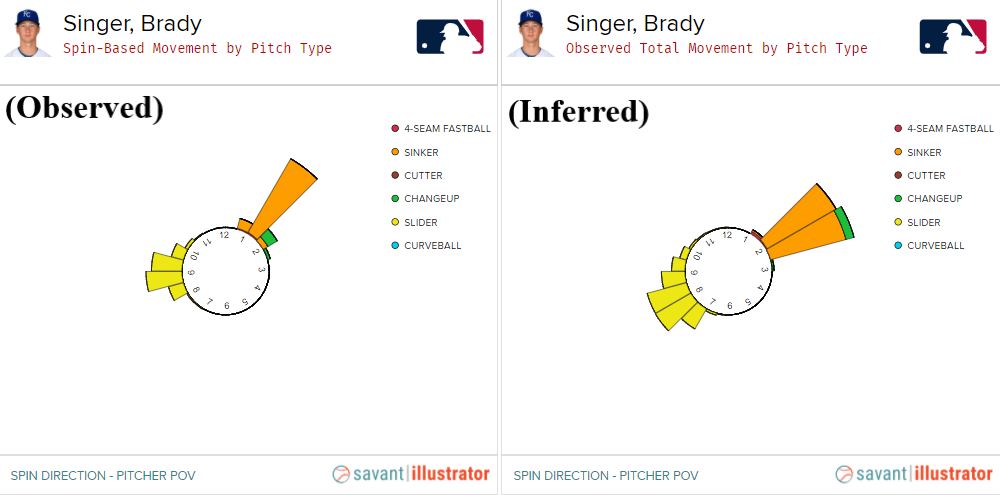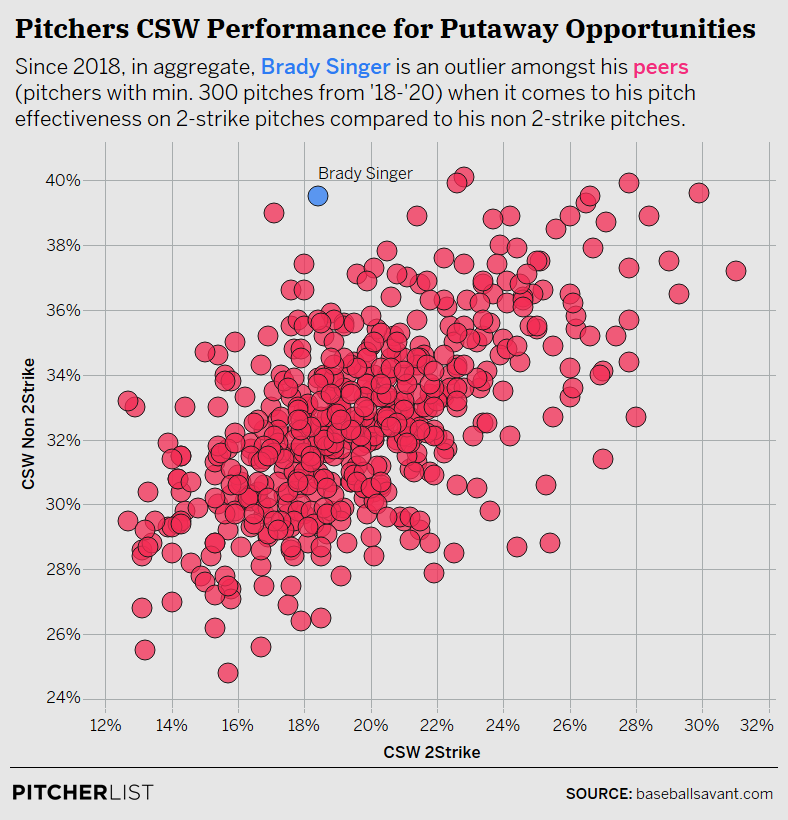Mike Leake never threw a minor league pitch. That’s unheard of! No one skips the minors. This article isn’t about Mike Leake, though. It’s about Brady Singer. Singer zoomed through High-A and Double-A in 2019, and by the time 2020 rolled around, he was major league-ready, throwing 64.1 innings of pretty darn good baseball. You couldn’t have asked for a quicker turnaround. What Singer does better than most is throw a lot of strikes, most of the time.
By CSW, he’s elite: he ranks in the 91st percentile of starting pitchers. By called strikes, though, his numbers are unsurpassed. Here’s a list of starters, by called strike percentage:
- Brady Singer, 22.8%
- Ross Stripling, 21.6%
- Zack Greinke, 21.4%
- Marco Gonzales, 21.4%
- Sonny Gray, 21.1%
None of these names are all that surprising. Stripling gets tons of called strikes with his curveball. Greinke is a premier command artist. So is Marco Gonzales. This is a newer thing for Gray, but it comes with an uptick in sinker usage.
You know who throws a sinker? Singer does! And apparently, it’s a good one. Another list, this time, showing pitchers’ fastballs (excluding cutters), by called strike percentage:
There’s Greinke again! This time, he’s joined by another Zach, and another Zac. Then there’s Arrieta and Civale. We always thought Singer would have a fine fastball—he has great command scouting grades—I’m just not sure anyone thought he would throw it for strikes like this. Of all starters who threw 40 or more innings, Singer has the second-lowest zone-swing percentage.
Of course, because his strikes are mostly called strikes, it’s fair to tentatively be more skeptical about his ability to sustain this level of converting pitches into strikes.
The other day, I wrote that Tejay Antone is a deceptive pitcher, and then I wrote that Evan Marshall is a deceptive pitcher just days later. Singer is a deceptive pitcher, too, which is why hitters take so many strikes. Of a group of 107 starters, Singer ranks the ninth-lowest in zone-swing percentage minus chase percentage (Z-O%), which puts him in the 92nd percentile. As I see it, that means that he’s more deceptive than 92% of starting pitchers. At least by this metric.
His command is a big part of it… sort of. But I think there’s another reason. and it’s awfully trendy nowadays. Singer’s sinker is of the seam-shifted wake variety.
Singer’s repertoire, by observed tilt (actual) on the left, and inferred tilt (recorded on release) on the right:

Now, Singer’s sinker isn’t as affected by seam-shifted wake as Kyle Hendricks‘, nor is it affected as, say, Corbin Burnes‘ sinker. Nevertheless, Singer’s sinker is released with a 1:45 spin direction, while the actual observed spin direction is with a 1:00 direction. This means that, in comparison to his spin direction on release, Singer’s sinker moves much more to his arm-side than batters would anticipate. This is where Singer’s deception comes into play.
Here’s Singer in action against righty Delino DeShields. The 0-0 pitch:
https://gfycat.com/sneakylightdowitcher
That’s not an easy pitch to do anything with. Singer spots on the bottom corner of the strike zone, sneaking in a backdoor sinker to start off the at-bat.
Then comes the 0-1 pitch:
https://gfycat.com/hilariousfinearchaeopteryx
Judging by the catcher’s body language, I’m not sure that Singer hits his spot per se, but his slider ends up in a location where he should be locating it, where looks like it could conceivably be a sinker, until it’s not. In any case, it’s enough to get DeShields to go around, drawing his second straight strike.
That sets up the 0-2 pitch:
https://gfycat.com/nicedefenselessibizanhound
Again, it looks like Singer misses to his glove-side. I imagine that the emphasis was on getting the ball below the plate, not off the plate to his glove-side, but it gets a whiff nonetheless. From a tunneling perspective, if either of the latter two pitches were a sinker and not a slider, DeShields probably makes contact! But they weren’t, and he didn’t. DeShields is, admittedly, not a very good hitter, but each pitch gave him fits in part due to the deception of both of Singer’s pitches that are derived from the effects of seam-shifted wake.
That all feels quite good. Despite his pedigree, Singer has been something of a surprise. At least to me. Of course, as is, Singer has two fatal flaws, the first of which I hinted at in the article title. I’ve talked about Singer’s CSW as a whole—he grades out really well by CSW—but it depends heavily on the context. A scatterplot of two-strike CSW versus non-two-strike CSW:

Data Visualization by @Kollauf on Twitter
In all counts, except for two-strike counts, Singer ranks in the 98th percentile. When looking solely at two-strike counts, though, Singer drops to the 40th percentile in CSW. That’s because he doesn’t have much in the way of an out-pitch. You would think his slider could be that pitch, but his slider’s 15.1% two-strike CSW is even worse than his sinker’s 21.1%. That’s a significant, significant problem. Singer gets to two-strike counts better than almost any other pitcher, but his lack of a chase pitch renders him mortal in two-strike counts.
This is where a pitcher with a lack of a third offering is desperately in need of a third offering. What’s interesting to me is that, to date, Dinelson Lamet has been able to get by with what is essentially a two-pitch mix, albeit in a vastly different way. Lamet leans on his slider over 50% of the time, which is a big reason why, like Singer, he throws a lot of strikes. The main difference is that, in two-strike counts, Lamet is able to weaponize his slider to make him one of the premier starters at putting hitters away. The only pitchers better are Corbin Burnes, Shane Bieber, and Tyler Glasnow. Great company!
And so, for Singer, a change is obviously in order. In most counts, he’s able to keep doing what he’s doing. But he needs a weapon. The slider, it seems, isn’t going to be it, and his changeup certainly isn’t the pitch either.
As I see it, he has a couple of options. He’s only thrown it a handful of times, but his four-seam fastball has the same observed spin direction as his sinker, so he could fold another layer of deception into his repertoire by throwing his a four-seam to play off of his slider, a la Spencer Turnbull. Another option (that isn’t mutually exclusive) would be for Singer to add a curveball to his repertoire and then take his slider and turn it into more of a cutter-slider hybrid. He could stand to learn something from Sonny Gray or Aaron Nola.
As is, Singer is plenty fine. He throws a good sinker, and he complements it with a solid slider. I’ll admit, it’s hard to think of that many pitchers that have had a bunch of success with a two-pitch repertoire in which they heavily rely on called strikes. I think Singer can be that guy, but there’s also an easy path to taking a big step forward. If he’s complacent with himself as is, he’ll be good. If he wants to build on his skill set, though, he could be great.
Photo by Scott Winters/Icon Sportswire | Adapted by Justin Redler (@reldernitsuj on Twitter)
Data Visualization by @Kollauf on Twitter

